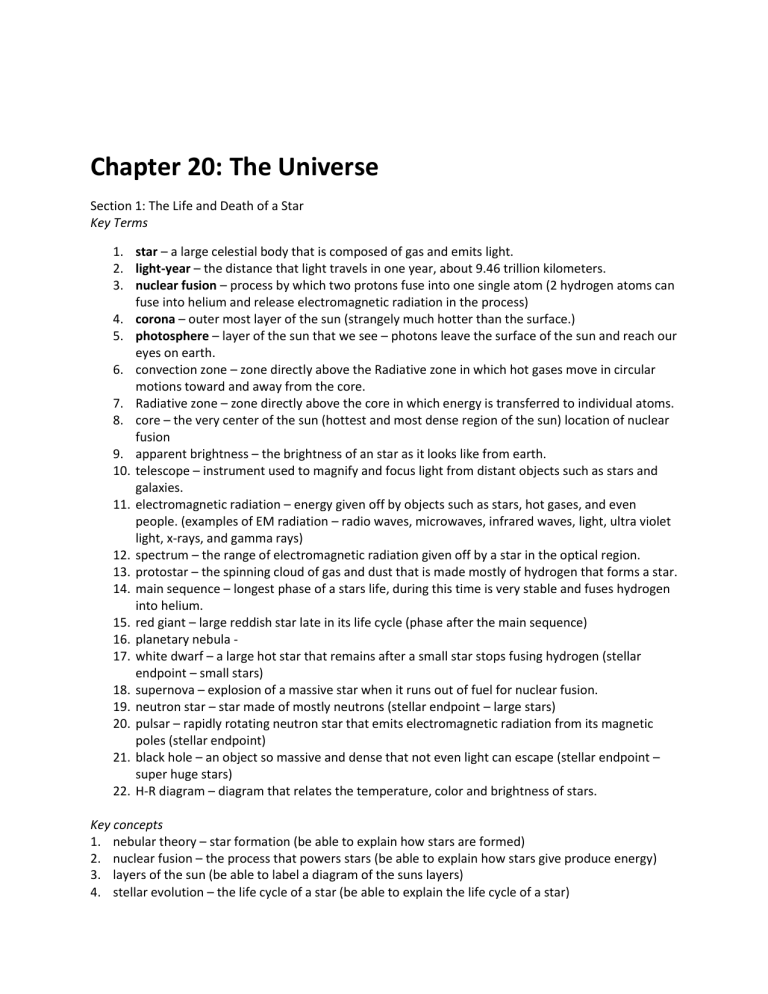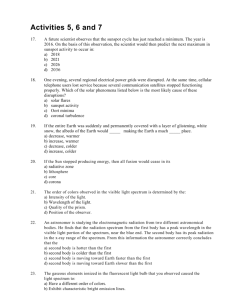Chapter 20 Section 1 notes

Chapter 20: The Universe
Section 1: The Life and Death of a Star
Key Terms
1.
star – a large celestial body that is composed of gas and emits light.
2.
light-year – the distance that light travels in one year, about 9.46 trillion kilometers.
3.
nuclear fusion – process by which two protons fuse into one single atom (2 hydrogen atoms can fuse into helium and release electromagnetic radiation in the process)
4.
corona – outer most layer of the sun (strangely much hotter than the surface.)
5.
photosphere – layer of the sun that we see – photons leave the surface of the sun and reach our eyes on earth.
6.
convection zone – zone directly above the Radiative zone in which hot gases move in circular motions toward and away from the core.
7.
Radiative zone – zone directly above the core in which energy is transferred to individual atoms.
8.
core – the very center of the sun (hottest and most dense region of the sun) location of nuclear fusion
9.
apparent brightness – the brightness of an star as it looks like from earth.
10.
telescope – instrument used to magnify and focus light from distant objects such as stars and galaxies.
11.
electromagnetic radiation – energy given off by objects such as stars, hot gases, and even people. (examples of EM radiation – radio waves, microwaves, infrared waves, light, ultra violet light, x-rays, and gamma rays)
12.
spectrum – the range of electromagnetic radiation given off by a star in the optical region.
13.
protostar – the spinning cloud of gas and dust that is made mostly of hydrogen that forms a star.
14.
main sequence – longest phase of a stars life, during this time is very stable and fuses hydrogen into helium.
15.
red giant – large reddish star late in its life cycle (phase after the main sequence)
16.
planetary nebula -
17.
white dwarf – a large hot star that remains after a small star stops fusing hydrogen (stellar endpoint – small stars)
18.
supernova – explosion of a massive star when it runs out of fuel for nuclear fusion.
19.
neutron star – star made of mostly neutrons (stellar endpoint – large stars)
20.
pulsar – rapidly rotating neutron star that emits electromagnetic radiation from its magnetic poles (stellar endpoint)
21.
black hole – an object so massive and dense that not even light can escape (stellar endpoint – super huge stars)
22.
H-R diagram – diagram that relates the temperature, color and brightness of stars.
Key concepts
1.
nebular theory – star formation (be able to explain how stars are formed)
2.
nuclear fusion – the process that powers stars (be able to explain how stars give produce energy)
3.
layers of the sun (be able to label a diagram of the suns layers)
4.
stellar evolution – the life cycle of a star (be able to explain the life cycle of a star)








